Just a minute before, the lights were flashing as in some underground disco club or at least a fairground curiously placed in the belly of Marble Mountain, Vietnam. And then there was a blackout! Possibly a power failure? A sudden revelation of the dark side of the Am Phu Cave? Was this how we would end up – being swallowed alive by the Hell Cave?
We were the last visitors of Vietnam’s Hell Cave, forgotten and abandoned. Nobody would come to the rescue!
In the darkness of the darkest cave of Marble Mountain, somewhere in Central Vietnam, Quoc and I were standing frozen. I met this student from Da Nang that day, but suddenly our destinies were more than connected.
Surely, they wouldn’t let the visitors of Am Phu Cave spend the night in this underground labyrinth! Somebody would get a torch and come and get us in no time!
But creepy silence and pitch darkness were overpowering the hopeful thoughts springing from the back of our minds. We were the last visitors of Vietnam’s Hell Cave, forgotten and abandoned. Nobody would come to the rescue!
If you are not faint-hearted, check out how Hindus use Batu Caves in Malaysia!
Marble Mountain, Vietnam – the sacred and the profane
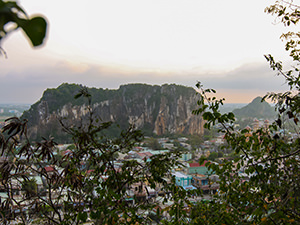
Eleven kilometers south of the center of Da Nang, an important Vietnamese port, or 18 kilometers north of Hoi An, a charming town of rich heritage, lays a cluster of five marble and limestone hills, known as the Marble Mountains.
Called Ngu Hanh Son in Vietnamese, their name literally translates as the mountains of five elements. Without Milla Jovovich connecting the stones, each mountain refers to the appropriate symbolic foundation. These are their names: Kim Son (metal), Tho Son (earth), Moc Son (wood), Hoa Son (fire), and Thuy Son (water).
These unusual outcrops, overgrown with trees, pierce the flat surrounding plains as some surreal grounded asteroids. The legend says these jutting rocks on Non Nuoc Beach were eggshells left on Earth by a dragon.
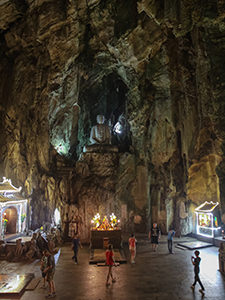
With caves and tunnels hidden below their surface, Cham people regarded these otherworldly mountains as sacred.
Nguyen, the last Vietnamese dynasty, rediscovered the mountains in the 19th century and sprinkled them with numerous shrines and pagodas.
During the Vietnam War, Viet Cong used the caves as hospital grounds, despite (or exactly because) of the proximity to the Americans.
Today, Marble Mountain is home to Hindu and Buddhist sanctuaries, above and underground. A place to look for inner peace.
It is also a tourist attraction, Vietnam’s hidden gem, one of those unmissable things to do in Vietnam.
If you are more into quirky attractions, check out the Crazy House Dalat!
“Free parking” for Am Phu Cave
I hopped on Quoc’s scooter in the center of Da Nang. We crossed the Han River over the famous Dragon Bridge that breathes actual fire. From then on, there was a straightforward path south towards the Marble Mountains, the place that will swallow us an hour later, in more than one meaning.
Just before arriving at Non Nuoc Village, known for its centuries of traditional stone carving craftsmanship, we got a stalker. Riding on a scooter parallel to us, the lady came from behind and started advocating for her courtyard as the perfect parking spot for our scooter. “It’s free! Free parking!”, she exclaimed while driving.
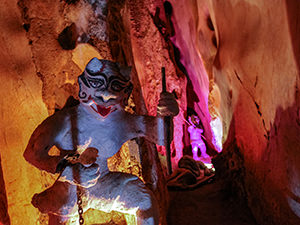
Quoc politely rejected her offer. As I found out later, there is no such thing as “free parking” in the village of the merchants on the foothill of one of Da Nang’s greatest attractions. Picking up your scooter from the “free parking place” might come with insisting on a purchase of some local artwork!
While greater sculptures in these artisan workshops could cost millions of dollars (at least, that’s what Quoc claimed), smaller pieces of art and jewelry could be much more affordable. But then again, it’s better to buy them with free will!
Thousands of artists created millions of sculptures in Non Nuoc Village. Buddhas, animals, mythological beings, chess sets… Before, these were carved out of the white marble mined locally. But now Marble Mountain is protected, and stonemasons import the material for their marble carvings from other parts of Vietnam and China.
The largest European show cave is located in Slovenia. Read more about the fascinating Postojna Cave, the home of baby dragons!
The Hell Cave of Vietnam, at Heaven’s doorsteps
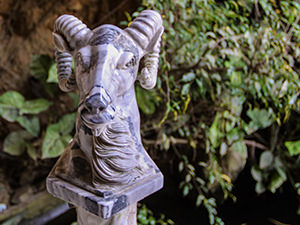
We arrived at the entrance of the Am Phu Cave just 20 minutes before 5 pm, the official closing time. But, literally, what the hell? We wouldn’t skip the opportunity to see the famous Hell Cave, even if it would be just a glimpse of it!
Am Phu is the Vietnamese word for hell. The godfather of the cave’s name was King Minh Mang in the 19th century. The story says that he sent soldiers with torches to explore the cave. But even after the twelfth torch was extinguished, they did not reach the bottom.
Set in Thuy Son, the largest of the five Marble Mountains, Am Phu Cave was the yin to its yang. It was the opposite of the heaven one could find on the top of the hill.
I found a corner of earthly paradise in Vietnam too - at Phu Quoc Island.
We left our scooter at the parking lot in front of the cave entrance and off we went.
A stone bridge surrounded by twelve columns, each with a sculpture of its own Zodiac sign, invited us over the symbolic Nai Ha River into the afterlife.
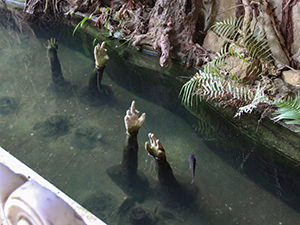
The souls with more sins than good deeds would be pushed into the pond representing the river, and become food for the dark monsters. Hands of sinners who didn’t make it were reaching out of the water, as if gasping for their last breath.
The longest cave in the Marble Mountains packed more than 300 meters of agony.
There was an installation of a court deciding on the weight of our sins and the level of the appropriate punishment.
One set of stairs led down to the deepest circles of hell. The other set of stairs promised to get you to the twinkle of the sunlight timidly entering through an opening in the top – the heaven.
On the top of the hill in Southern Vietnam, there is a monument to Christianity! Check out the statue of Jesus in Vung Tau!
Am Phu Cave’s dark side
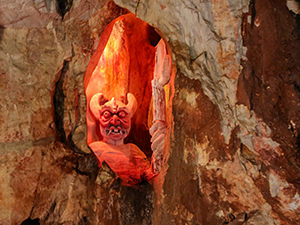
Am Phu Cave was a natural grotto but filled with phantasmagoric images of our nightmares. This recreation of the Buddhist hell offered vivid lectures on what happens to the worst of our kind on judgment day.
There were bloodthirsty demons lurking behind every corner, exposing their greedy fangs and craving gaze.
Sizzling on a human barbecue, being whipped on a pillar of shame, or being offered as food to crocodiles and snakes in their hungriest hours, were just some of the methods to execute universal justice.
The underworld of torture and mutilation was filled with burning incense. There were altars where believers came to repent, pray, and leave offerings.
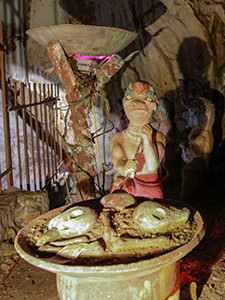
Am Phu Cave was a pragmatic interpretation of how Karma works. Every action comes with consequences. If one wants to avoid the purgatory of endless suffering, now is the moment to get better!
In the deepest part of this humid grotto, called Nguc A Ty (A Ty Jail), there was a statue of Muc Kien Lien (Maudgalyayana) visiting his mother in hell. One of Buddha’s closest disciples, who actually ended his life in violent death as the execution of Karma for killing his own parents in a previous life, here came to comfort his mother in hell with a bowl of rice. Even Buddha couldn’t use his magical powers to help his mother, but he did tell his student that saving her could be possible if he summoned many monks for a prayer on the full moon day of the seventh lunar month.
These were the origins of the Vu Lan Festival, or the Ghost Festival, when Vietnamese believe the gates of hell open and the wandering souls get a 24-hour rest. It is also the day to show gratefulness to one’s parents.
There is a very peculiar afterlife for soldiers who died in one of the most important battles of the 19th century. Their bones and skulls decorate the walls of the ossuary churches in Solferino and San Martino.
Am Phu Cave lesson: Hell has no exit
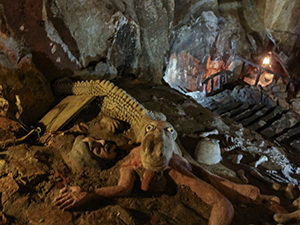
Candles trembling in Am Phu Cave, in memory of the departing dead, were accompanied by the modern light effects, spilling bloody red over the cave walls. Stalactites and stalagmites washed in the colors of our life liquid could be a great set-up for a horror movie.
Luckily, the execution of some of the art was naïve enough that even children would be able to laugh it off.
Then there was a steep staircase towards the first indications of heaven. Artistic execution was becoming much nicer up here. Crane-riding fairies, Lady Buddha, dragons, other winged creatures…
The path was rough, narrow, and twisted, and in the middle of our climb – somebody switched off the light. Suddenly, the horror became much more tangible, as the heaven we were climbing to ended up being a dead-end street. Sure, the lookout at the opening provided some nice views over the area, but the only way out of the Am Phu Cave was back through hell again.
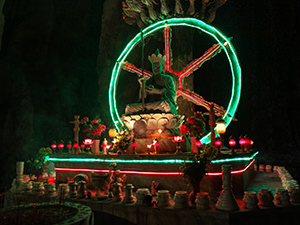
Just seconds ago, I was finding the decorative lights covering the cave altars extremely kitschy. Oh, how beautiful those flaring lights would have been if they would’ve revealed the stairs to this chasm, the safe way out!
The idea that we could stumble in the darkness, and fall into a deep abyss, with no mobile phone signal or anyone looking for us until morning, when we would probably get confused for some exhibit, suddenly sent chills down our spines. Would I end my life in – hell?
Thanks to modern technology, and the fact that I didn’t spend the whole battery of my phone on taking pictures of the tacky interior design, the phone’s torch lighted up our descent into hell.
With some basic orientation skills, we found our way out of the Am Phu Cave, to live another day.
People were always fascinated by caves, and Slovenians even built a castle in one of them! You have to see it to believe it - this is Predjama Castle!
Scooter in the hands of the Hells Angels
We rubbed the sculptures of our Zodiac signs for luck and decided to explore the outside of the Thuy Son. There was a Marble Mountain elevator bringing the lazy ones to the top, but we decided to explore the mountain’s pagodas, impressive outdoor sculptures, and some more shrine caves on foot.
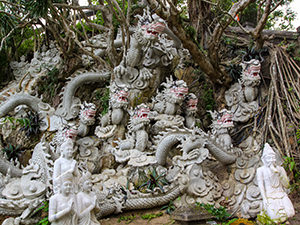
When we decided to call it a day and came back to the parking lot, there was a final surprise waiting. Our scooter was not there anymore! What the hell? Did someone just steal our vehicle, risking that such a crime could throw them into the deepest circles of Am Phu Cave?
We were melting from the hike already, but the cold drops of sweat rolling down our forehead were accompanying the sudden panic attack.
In the nowempty parking lot, the security guard was pushing us to leave. Quoc was trying hard to explain that we had a scooter parked there, but the guard had eyes. The lot was empty and we were ‘just messing up with him’. He wanted us to leave. Only the parking ticket we did not discard was proving we were not trying to pull a prank.
Oh, where was now that lady on the scooter and her free parking? We were ready to buy any silly trinket just to reunite with Quoc’s motorbike!
This lasting anxiety did not die down until, somehow, we did see the scooter sheltered in the hidden corner of the parking lot. Certainly not the place where we parked it! Our heart was back in place. The Hells Angels were looking after us.
Did you like this article on Am Phu Cave in Marble Mountain, Vietnam?
Pin it for later!
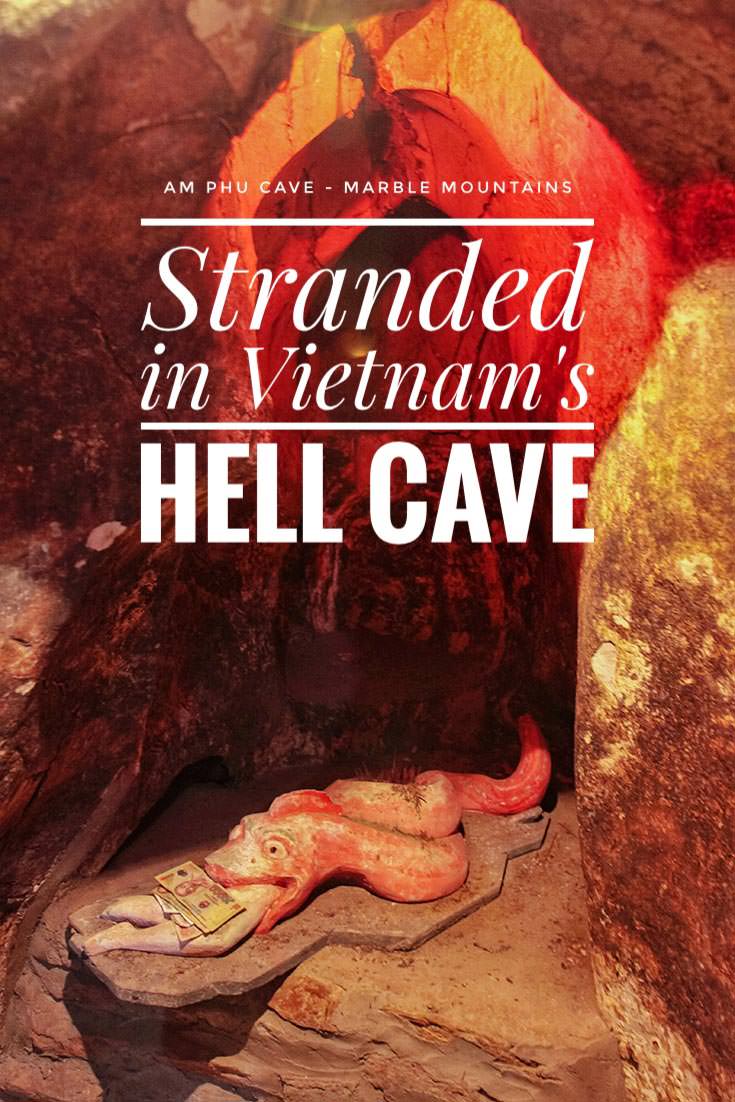
Know before you visit Am Phu Cave, the Hell Cave of Vietnam
Where to stay in Da Nang?
If you’re looking for places to stay near Am Phu Cave, consider booking these hotels and resorts in Da Nang!
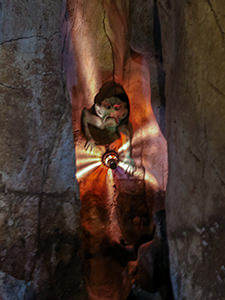
How to go to Marble Mountain & Am Phu Cave?
Take the road from Da Nang towards Hoi An called Le Van Hien. Turn left to Huyen Tran Cong Chua, which will bring you directly to the entrance of the Marble Mountains.
Besides your own transport, you can also visit the Marble Mountains by bus – no. 1 or 11. The ticket should not cost more than 17.000 VND (65 cents).
If you just want to visit the Am Phu Cave, don’t climb the stairs; the entrance is at the bottom of Thuy Son!
How long to spend at the Marble Mountains?
You can easily spend 3 to 4 hours at Marble Mountain. Go slowly, do it at a human pace!
The best time to visit Marble Mountain, Vietnam
If you can, travel to Marble Mountains between January and April. In the wet season, the marble stairs can become wet.
The Am Phu Cave is open seven days a week, from 7 am to 5 pm. Don’t be late, if you don’t want to spend the night inside!
Am Phu entrance fee: 20.000 VND (75 cents)
Parking fee: 10.000 VND (40 cents)
Disclosure: This post contains affiliate links, which means if you click on them and make a purchase, Pipeaway might make a small commission, at no additional cost to you. Thank you for supporting our work!

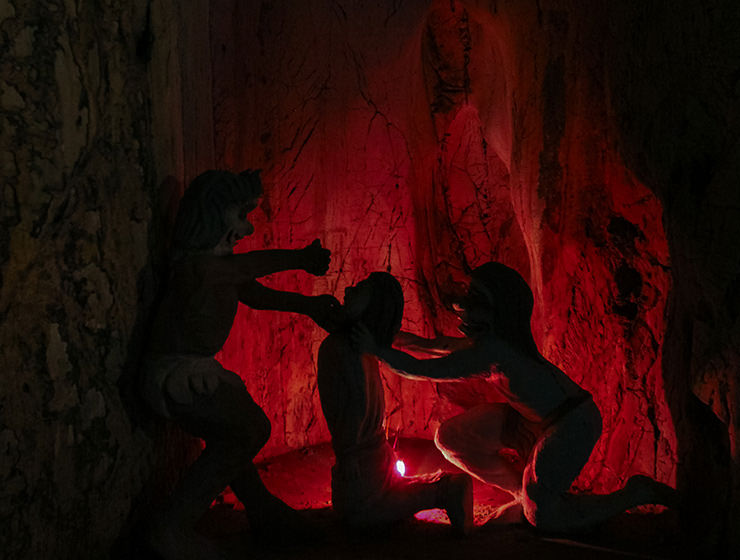

Dear God!!! This would have been a nightmare for me! So glad you found your way out, lol!
Well, OK, it’s not the hugest cave in the world. And luckily, we had some light on our mobile phones 😉
But a good lesson there: always bring a headlight when heading to dark places!
This is such a scary experience. Thankfully, it all worked out and you found your scooter.
Well, it seems that even in Hell Cave one can get lucky 😉